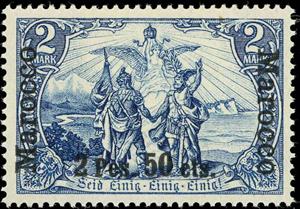Stamp: General Post Office, Berlin - overprinted (Morocco, German Post Offices 1905)
General Post Office, Berlin - overprinted (Morocco, German Post Offices 1905)
01 January (Morocco, German Post Offices ) within release German Realm stamps overprinted in 1905 goes into circulation Stamp General Post Office, Berlin - overprinted face value 2.50 Spanish peseta
| Stamp General Post Office, Berlin - overprinted in catalogues | |
|---|---|
| Michel: | Mi: DR-MA VIIIl |
Stamp is horizontal format.
Prepared but not issuedAlso in the issue German Realm stamps overprinted in 1905:
- Stamp - General Post Office, Berlin - overprinted face value 1.25;
- Stamp - General Post Office, Berlin - overprinted face value 2.50;
- Stamp - General Post Office, Berlin - overprinted face value 3.75;
- Stamp - General Post Office, Berlin - overprinted face value 6.25;
- Stamp - Germania with imperial crown, hatched background face value 3;
- Stamp - Germania with imperial crown, hatched background face value 5;
- Stamp - Germania with imperial crown, hatched background face value 10;
- Stamp - Germania with imperial crown, hatched background face value 25;
- Stamp - Germania with imperial crown, hatched background face value 30;
- Stamp - Germania with imperial crown, hatched background face value 35;
- Stamp - Germania with imperial crown, hatched background face value 50;
- Stamp - Germania with imperial crown, hatched background face value 60;
- Stamp - Germania with imperial crown, hatched background face value 1;
Stamp General Post Office, Berlin - overprinted it reflects the thematic directions:
In Abrahamic religious traditions (such as Judaism, Christianity, and Islam) and some sects of other belief-systems like Hinduism and Buddhism, an angel is a heavenly supernatural or spiritual being. In monotheistic belief-systems, such beings are under service of the supreme deity (i.e. God).
Abrahamic religions often depict angels as benevolent celestial intermediaries between God and humanity. Other roles include protectors and guides for humans, such as guardian angels and servants of God.[3] Abrahamic religions describe angelic hierarchies, which vary by religion and sect. Some angels have specific names (such as Gabriel or Michael) or titles (such as seraph or archangel). Malevolent angels are often believed to have been expelled from Heaven and called fallen angels. In many such religions, the Devil (or devils) are identified with such angels
A coat of arms is an heraldic visual design on an escutcheon (i.e. shield), surcoat, or tabard. The coat of arms on an escutcheon forms the central element of the full heraldic achievement which in its whole consists of shield, supporters, crest, and motto. A coat of arms is traditionally unique to an individual person, family (except in the United Kingdom), state, organisation or corporation.
A flag is a piece of fabric (most often rectangular or quadrilateral) with a distinctive design that is used as a symbol, as a signaling device, or as decoration. The term flag is also used to refer to the graphic design employed, and flags have since evolved into a general tool for rudimentary signalling and identification, especially in environments where communication is similarly challenging (such as the maritime environment where semaphore is used). National flags are patriotic symbols with varied wide-ranging interpretations, often including strong military associations due to their original and ongoing military uses. Flags are also used in messaging, advertising, or for other decorative purposes. The study of flags is known as vexillology, from the Latin word vexillum, meaning flag or banner.



